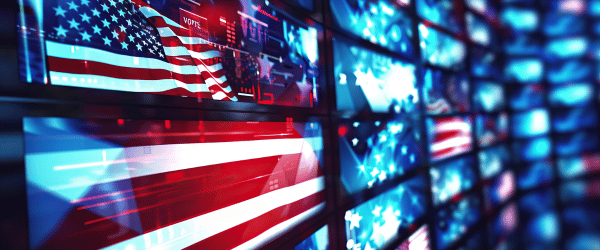Navigating Media Buying in an Election Year – Key Considerations
By Lakshimi Sarju & Riya Sherchan
During an election year, brands and their respective media agencies must take a thoughtful approach to their media strategies. Marketing initiatives must be aligned to fit the changing political environment. As a result, brands may need to effectively try to reach target audiences in unique ways across media. A strong option to consider is leveraging more digital media which can be executed quickly in a more nimble, targeted manner, while at the same time being agile in their creative content approach in order to maintain brand equity and trust.
Spot TV Buy Strategies
During an election year, most TV ads (around 80%) are reserved for spot TV, which can make it a challenging market for advertisers to break into. Spot buys are in high demand during election season, and prices are most likely to be very inflated. We have even seen some networks artificially increase their rates before the election period, making it crucial for media agencies to negotiate with their vendors and not accept inflated rates out of the gate.
Brands should avoid spot buys as much as possible due to the higher rates and need to be agile when it comes to ad context and content. Given inflated prices, it also may be a good idea to reconsider buying ads on news networks during specific dayparts. If you are looking to avoid paying premium prices for limited reach that may not break through, it is important to steer clear of these areas.
In 2024, popular dayparts for political ads on spot TV include early morning, early news, late news, early fringe, and prime access. Cable news stations are also prime locations for political ad investment. However, with eMarketer projecting political ad spend to surpass $12 billion in 2024, advertisers may find it beneficial to explore alternative dayparts such as daytime, late fringe, and weekends, along with non-news cable channels. This strategy can help mitigate political preemptions and cut through the clutter of political advertisements.

Election Years and Under Delivery
Media agencies may find it increasingly difficult to execute “make goods” due to a saturated advertising market. “Make goods” refers to compensation or additional advertising provided by media partners to compensate for any discrepancies or shortcomings in the original advertising placement.
During an election year, it is expected that an increased amount of under-delivery will occur, which means that media partners may fail to deliver on the agreed-upon number of impressions, views, or exposures specified in the advertising contract. So, it’s essential to prepare for some under-delivery and adjust expectations accordingly.
Shifting Investments to Stay Ahead of the Curve
One strategic move is to focus on building a strong digital and connected presence. This involves shifting investments towards digital display, CTV, and paid social media platforms, leveraging programmatic choices. Programmatic buys (Digital and CTV) are forecasted to increase by 13% in 2024 vs last year, with over 50% of the ad spend in programmatic video.
Ad spend is also expected to increase significantly for programmatic mobile, programmatic digital out-of-home and programmatic digital audio in 2024. This creates a unique opportunity for advertisers to engage audiences in various contexts. Shifting media investments to these channels can help advertisers stay ahead of the curve and maximize their impact in reaching and engaging their target audience.
Paid Social Media Investments
Using paid social media platforms during presidential campaigns can lead to the dissemination of misinformation making brand safety crucial for 2024 planning. The proliferation of fake AI-generated images and robocalls impersonating candidates are common examples. Additionally, political groups’ ad buys reduce available inventory for other users, driving up the cost of ads. Despite their effectiveness, these ads become more expensive as demand rises. As an alternative solution, advertisers are advised to utilize platforms like TikTok, where political ads are banned.
Traditional Broadcast and Radio Buys
Traditional broadcasting and radio channels are likely to be dominated by political campaigns, making digital platforms a more viable and less saturated alternative. However, it is important to note that achieving Reach/Frequency thresholds across all media in battleground states (such as Arizona, Georgia, Michigan, Nevada, North Carolina, Pennsylvania, and Wisconsin) will still be challenging. It is critical to constantly evaluate and tweak your buying strategy in these areas while in-market.
Opportunities in Underutilized Channels
Finally, it’s important not to overlook underutilized channels such as native advertising, streaming audio, and digital OOH. These channels can provide valuable opportunities to reach audiences in less competitive environments. While election years bring unique challenges for media buying, careful planning, and a more adaptable buying and measurement approach will help brands navigate these challenges successfully. Stay flexible, be strategic, and remember that there’s always an opportunity to quickly adapt and change.
